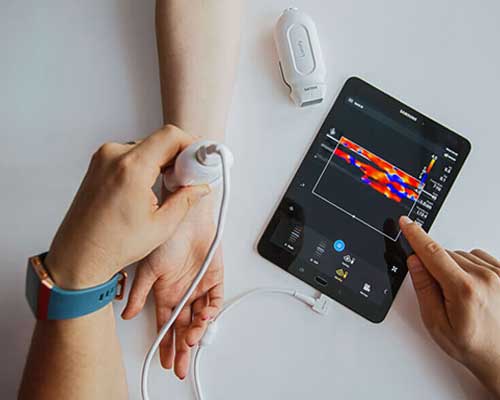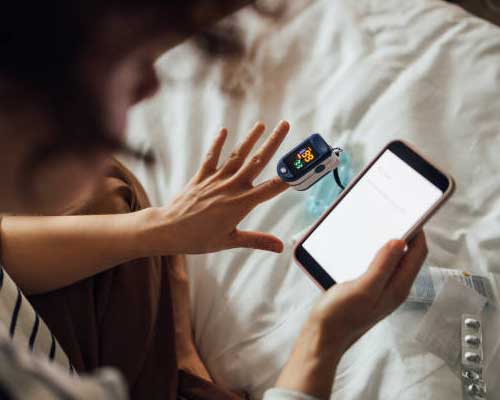The Benefits of Wearable Devices for Real-Time Patient Monitoring
In today’s fast-paced world, technology has become an integral part of our daily lives. From smartphones to smartwatches, we are constantly connected and have access to information at our fingertips. This advancement in technology has also made its way into the healthcare industry, with the development of portable medical devices that can enhance patient monitoring.
One of the most significant benefits of wearable devices for real-time patient monitoring is the ability to track vital signs and health data continuously. Traditional methods of monitoring, such as taking a patient’s blood pressure or heart rate, only provide a snapshot of their health at a specific moment. With wearable devices, healthcare professionals can now have access to real-time data, allowing them to monitor a patient’s health continuously.
This continuous monitoring is especially beneficial for patients with chronic conditions such as diabetes, heart disease, or respiratory issues. These patients require regular monitoring of their vital signs, and wearable devices provide a convenient and non-invasive way to do so. By tracking their health data in real-time, healthcare professionals can detect any changes or abnormalities early on, allowing for prompt intervention and better management of their condition.
Moreover, wearable devices also allow for remote patient monitoring, which is particularly useful for patients who live in remote areas or have limited mobility. With the use of these devices, patients can now receive quality healthcare without having to leave the comfort of their homes. This not only saves them time and money but also reduces the risk of exposure to illnesses in a hospital setting.
Another significant benefit of wearable devices is the ability to collect and analyze a vast amount of data. These devices can track various health metrics, such as heart rate, blood pressure, sleep patterns, and physical activity. This data can then be synced to a smartphone or computer, where it can be analyzed by healthcare professionals. By having access to this data, healthcare providers can gain valuable insights into a patient’s health and make more informed decisions about their treatment plan.
Furthermore, wearable devices also promote patient engagement and empowerment. Patients can now take an active role in managing their health by tracking their health data and setting personal health goals. This not only encourages patients to make healthier lifestyle choices but also allows them to have a better understanding of their condition and how it is affected by their daily habits.
In addition to monitoring vital signs, wearable devices can also track medication adherence. For patients with chronic conditions, it is crucial to take their medication as prescribed to manage their condition effectively. However, studies have shown that many patients struggle with medication adherence. With the use of wearable devices, healthcare professionals can now monitor if a patient has taken their medication and send reminders if they have not. This can significantly improve medication adherence and ultimately lead to better health outcomes.
Moreover, wearable devices also have the potential to reduce healthcare costs. By continuously monitoring a patient’s health, healthcare professionals can detect any changes or complications early on, preventing costly hospitalizations or emergency room visits. Additionally, remote patient monitoring can also reduce the need for in-person appointments, saving both patients and healthcare providers time and resources.
In conclusion, the benefits of wearable devices for real-time patient monitoring are numerous. From continuous monitoring and remote patient care to data collection and patient empowerment, these devices have the potential to revolutionize the way we approach healthcare. As technology continues to advance, we can expect to see even more innovative and effective wearable devices that will further enhance patient monitoring and improve health outcomes.
Revolutionizing Patient Care: The Impact of Portable Medical Technology
In today’s fast-paced world, technology has become an integral part of our daily lives. From smartphones to smart homes, we rely on technology to make our lives easier and more efficient. This is also true in the field of healthcare, where advancements in technology have revolutionized patient care. One such advancement is the development of portable medical technology, which has greatly enhanced patient monitoring.
Portable medical technology refers to medical devices and equipment that are designed to be compact, lightweight, and easily transportable. These devices are specifically designed to be used outside of traditional healthcare settings, such as hospitals and clinics. They allow for real-time monitoring of a patient’s vital signs and other important health data, providing healthcare professionals with valuable information to make informed decisions about a patient’s care.
One of the main benefits of portable medical technology is its ability to enhance patient monitoring. In the past, patients had to be admitted to a hospital or clinic for continuous monitoring, which could be inconvenient and costly. With portable medical devices, patients can now be monitored in the comfort of their own homes or even while on the go. This not only improves the patient’s quality of life but also reduces the burden on healthcare facilities.
One example of portable medical technology that has greatly enhanced patient monitoring is the portable electrocardiogram (ECG) device. This device allows for the continuous monitoring of a patient’s heart rate and rhythm, providing valuable information for the diagnosis and management of heart conditions. Patients can wear the device for an extended period, and the data can be transmitted to their healthcare provider in real-time. This allows for early detection of any abnormalities and timely intervention, which can be life-saving in some cases.
Another example is the portable pulse oximeter, which measures the oxygen saturation levels in a patient’s blood. This device is particularly useful for patients with respiratory conditions, such as asthma or chronic obstructive pulmonary disease (COPD). By monitoring their oxygen levels at home, patients can better manage their condition and seek medical attention if necessary. This not only improves their quality of life but also reduces the risk of hospitalization.
Portable medical technology has also greatly enhanced patient monitoring for those with chronic conditions, such as diabetes. Continuous glucose monitoring (CGM) devices allow for the real-time monitoring of a patient’s blood sugar levels, providing valuable information for the management of diabetes. These devices can be worn for an extended period, and the data can be transmitted to a healthcare provider for analysis. This allows for better management of the condition and reduces the risk of complications.
In addition to enhancing patient monitoring, portable medical technology also promotes patient empowerment. By allowing patients to monitor their own health data, they become more involved in their care and can make informed decisions about their health. This can lead to better self-management of chronic conditions and improved overall health outcomes.
Furthermore, portable medical technology has also improved the efficiency of healthcare delivery. With real-time monitoring and data transmission, healthcare professionals can make timely and accurate decisions about a patient’s care. This reduces the need for unnecessary hospital visits and allows for more efficient use of healthcare resources.
In conclusion, portable medical technology has revolutionized patient care by enhancing patient monitoring. These devices allow for real-time monitoring of vital signs and other health data, providing valuable information for the diagnosis and management of various conditions. They also promote patient empowerment and improve the efficiency of healthcare delivery. As technology continues to advance, we can expect to see even more innovative portable medical devices that will further enhance patient monitoring and improve overall healthcare outcomes.
Improving Patient Outcomes with Portable Medical Devices: A Case Study
In today’s fast-paced world, technology has become an integral part of our daily lives. From smartphones to smart homes, we rely on technology to make our lives easier and more efficient. This is especially true in the field of healthcare, where advancements in technology have greatly improved patient outcomes. One such advancement is the development of portable medical devices, which have revolutionized patient monitoring.
Portable medical devices are small, lightweight, and easy to use devices that can be carried by patients wherever they go. These devices are designed to monitor various vital signs and health parameters, providing real-time data to healthcare professionals. This allows for continuous monitoring of patients, even outside of traditional healthcare settings. In this article, we will explore how portable medical technology enhances patient monitoring and improves patient outcomes through a case study.
The case study involves a 65-year-old patient, Mr. Smith, who suffers from chronic obstructive pulmonary disease (COPD). COPD is a progressive lung disease that makes it difficult for patients to breathe. Mr. Smith’s condition requires constant monitoring of his oxygen levels, heart rate, and respiratory rate. In the past, he had to visit his doctor’s office regularly for check-ups, which was not only time-consuming but also inconvenient for him.
However, with the introduction of portable medical devices, Mr. Smith’s life has changed for the better. He now uses a portable pulse oximeter, a small device that measures oxygen levels in the blood, and a portable spirometer, a device that measures lung function. These devices are connected to his smartphone, which allows him to track his health data in real-time and share it with his doctor.
The use of portable medical devices has greatly enhanced Mr. Smith’s patient monitoring experience. He no longer has to make frequent trips to the doctor’s office, as his doctor can monitor his health remotely. This has not only saved him time and money but has also improved his overall quality of life. With the help of these devices, Mr. Smith’s doctor can detect any changes in his health early on and make necessary adjustments to his treatment plan.
Moreover, portable medical devices have also improved the accuracy of patient monitoring. In traditional healthcare settings, vital signs are usually measured manually, which can lead to human error. However, with portable devices, the data is collected automatically, eliminating the risk of human error. This ensures that the data collected is accurate and reliable, allowing for better decision-making by healthcare professionals.
Another benefit of portable medical devices is their ability to provide real-time data. In the case of Mr. Smith, his doctor can monitor his health data in real-time, even when he is at home or on the go. This allows for early detection of any potential health issues, which can be crucial in managing chronic conditions like COPD. Real-time data also allows for timely interventions, reducing the risk of complications and hospitalizations.
In conclusion, portable medical technology has greatly enhanced patient monitoring and improved patient outcomes. The case study of Mr. Smith is just one example of how these devices have revolutionized healthcare. With the use of portable medical devices, patients can now take an active role in their own healthcare and have better control over their health. As technology continues to advance, we can expect to see even more innovative and effective portable medical devices that will further improve patient outcomes.





